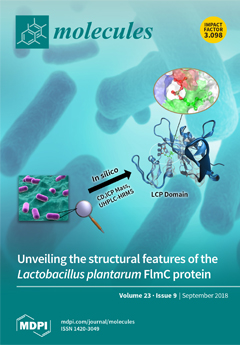In the course of screening for microbes with antifungal activity, we found that the culture filtrate of the IUM00035 isolate exhibited strong antifungal activity against
Magnaporthe oryzae and
Colletotrichum coccodes in planta. Based on the phylogenetic analysis with the ITS region, the IUM00035 isolate was identified as
Crinipellis rhizomaticola. To identify antifungal compounds from the
C. rhizomaticola IUM00035 isolate, the culture filtrate of the isolate was partitioned with ethyl acetate and
n-butanol and, consequently, two active compounds were isolated from the ethyl acetate extract. The chemical structures of the isolated compounds were determined as crinipellin A (
1) and a new crinipellin derivative, crinipellin I (
2), by NMR spectral analyses and a comparison of their NMR and MS data with those reported in the literature. Crinipellin A (
1) exhibited a wide range of antifungal activity in vitro against
C. coccodes,
M. oryzae,
Botrytis cinerea, and
Phytophthora infestans (MICs = 1, 8, 31, and 31 µg/mL, respectively). Furthermore, when plants were treated with crinipellin A (
1) (500 µg/mL) prior to inoculation with fungal pathogens, crinipellin A (
1) exhibited disease control values of 88%, 65%, and 60% compared with non-treatment control against tomato late blight, pepper anthracnose, and wheat leaf rust, respectively. In contrast to crinipellin A (
1), crinipellin I (
2) showed weak or no activity (MICs > 250 µg/mL). Taken together, our results show that the
C. rhizomaticola IUM00035 isolate suppresses the development of plant fungal diseases, in part through the production of crinipellin A (
1).
Full article






